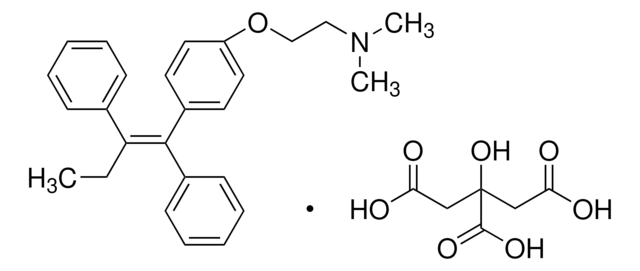H7904
(Z)-4-Hydroxytamoxifen
≥98% (HPLC), powder, estrogen receptor modulator
Synonym(s):
4OH-Tamoxifen, (Z)-4-(1-[4-(Dimethylaminoethoxy)phenyl]-2-phenyl-1-butenyl)phenol, (Z)-4-OHT, trans-4-Hydroxytamoxifen
About This Item
Recommended Products
product name
(Z)-4-Hydroxytamoxifen, ≥98% Z isomer
Quality Level
Assay
≥98% (HPLC)
form
powder
storage condition
desiccated
protect from light
solubility
methanol: 10 mg/mL
ethanol: 20 mg/mL (with heating)
antibiotic activity spectrum
neoplastics
Mode of action
enzyme | inhibits
originator
AstraZeneca
storage temp.
2-8°C
SMILES string
CC\C(c1ccccc1)=C(/c2ccc(O)cc2)c3ccc(OCCN(C)C)cc3
InChI
1S/C26H29NO2/c1-4-25(20-8-6-5-7-9-20)26(21-10-14-23(28)15-11-21)22-12-16-24(17-13-22)29-19-18-27(2)3/h5-17,28H,4,18-19H2,1-3H3/b26-25-
InChI key
TXUZVZSFRXZGTL-QPLCGJKRSA-N
Gene Information
human ... ESR1(2099) , ESR2(2100) , ESRRG(2104) , IL6(3569)
rat ... Ar(24208) , Esr1(24890) , Esr2(25149)
General description
Application
- as a media supplement to study the cell viability by WST-1 Assay
- for inducing deletion of transforming growth factor-β (TGF-β gene in mice
- to induce Cre recombinase activity in vitro.
Features and Benefits
Signal Word
Danger
Hazard Statements
Precautionary Statements
Hazard Classifications
Acute Tox. 4 Oral - Aquatic Acute 1 - Aquatic Chronic 1 - Carc. 1B - Repr. 1B
Storage Class Code
6.1C - Combustible acute toxic Cat.3 / toxic compounds or compounds which causing chronic effects
WGK
WGK 3
Flash Point(F)
Not applicable
Flash Point(C)
Not applicable
Personal Protective Equipment
Certificates of Analysis (COA)
Search for Certificates of Analysis (COA) by entering the products Lot/Batch Number. Lot and Batch Numbers can be found on a product’s label following the words ‘Lot’ or ‘Batch’.
Already Own This Product?
Find documentation for the products that you have recently purchased in the Document Library.
Customers Also Viewed
Articles
The CRISPR-Cas9 system is an RNA-guided genome-editing tool that provides researchers a simple, easy, and quick way to modify the genomes of various organisms.
Our team of scientists has experience in all areas of research including Life Science, Material Science, Chemical Synthesis, Chromatography, Analytical and many others.
Contact Technical Service








